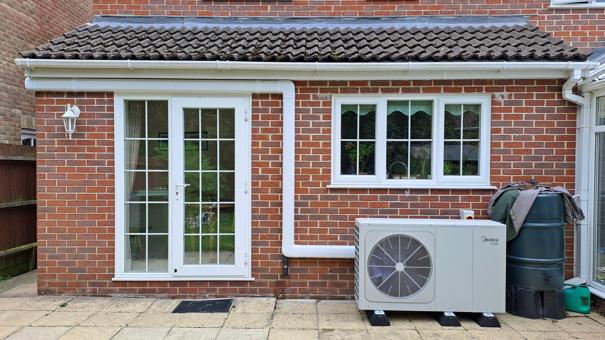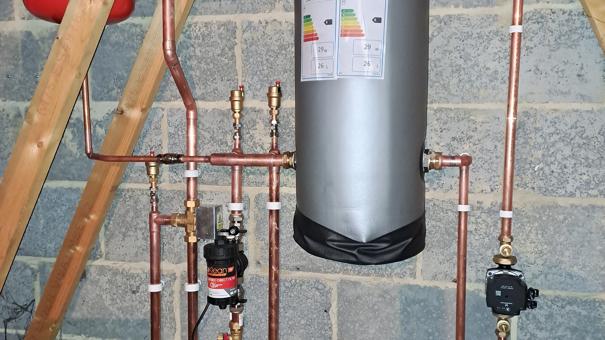Matthew and Patricia had a 10kW air source heat pump installed in early August 2023, replacing their ageing gas boiler system. Having had an energy efficiency assessment completed, which showed that their property had adequate loft insulation, cavity walls and double-glazing, it seemed the logical next step.
They tell us more...

Our Home
We live in a 1997-build, four-bedroom detached property. It was previously heated by a 25-year old, E-rated gas boiler.
As the boiler was coming to the end of life, we decided that we didn't want to continue burning fossil fuels to heat our home and so investigated installing a heat pump. We already have solar panels, a battery and an electric car. The house had adequate cavity wall and loft insulation and was double-glazed throughout, so there was no major work to be done to be ready for a heat pump.
We chose a 10kW Midea heat pump, which runs at 50 degrees. The lower-temperature of the system meant that we also needed to upgrade most of the radiators in our home, but not the microbore pipes running to these radiators.
The decision to switch was not made on economic grounds, but from a desire to be greener. It was also a type of pilot: we decided to retain a backup gas heating facility until and unless we were convinced the house would remain sufficiently warm.
And we also agreed it would be sensible to assess, after a period of time, whether the switch was effective. This post is the result of that assessment.

The Installation
The installation took four days in August 2023.
The hot water cylinder was changed for a larger capacity one. The majority of radiators were upgraded to double-thickness radiators. We requested an additional radiator in the dining area, as this was previously the coldest room in the house. Additional expansion cylinders and pipework were installed in the loft, as seen in the picture.
We use a clever system called "Homely" to control the heat pump via an app on our phones. There is a small thermostat that can be positioned in any room of the house. We set the desired room and hot water temperatures, and the time of day we want these, and then leave Homely to determine when the heat pump needs to run. It knows about our electricity tariff, so can run the heating at the most cost-effective times for us.
We’ve been just as warm with the heat pump as we were with the gas heating - with noticeably fewer highs and lows using the heat pump, which runs for a much longer period of the day than the gas boiler did.
The Results
We’ve saved over 70% of the total energy* required to heat our house and roughly 29% of the costs of heating our house by switching to the heat pump. This is despite the electricity cost-per-kWh doubling between the time periods. This was a surprise as all of the internet doom-and-gloom suggested we would find it more expensive to heat our home with a heat pump.


The headline figures above were calculated by comparing gas usage before and after the switch to electricity usage before and after the switch. Differences between the two were ascribed to the switch from gas boiler to air source heat pump.
* This figure probably underestimates the energy savings, as we have had changes in our car and battery usage that have also impacted the amount of electricity we are consuming.
Time Period
We have had the system for a full year, so the comparisons are August 2022 - August 2023 for the "Before" period, and August 2023 - August 2024 for the "After" period.
In both cases the months are billing months, broadly starting in the middle of a given calendar period. These don’t align across the suppliers (gas tends to be billed several days after electricity) but we’ve ignored this difference in the total calculations.
Solar Generation
Between roughly March and the end of September we’ve confused our electricity situation with the solar system providing a substantial offset, which complicates trying to work out from bill data how much power we’ve actually used. Although we've got data on the totals generated vs consumed, trying to turn that into a financial figure (accounting for rate changes, time-of-day billing, losses due to battery charge/discharge) is just about impossible.
Having said all that, we have used the “Net” figures for electricity cost (i.e. those that include the payback from export) rather than the “Gross” figures. Because this is the difference we feel in the wallet due to the switch.
We have used the “Gross” figures for energy consumption, taking no account of any exported electricity in the heating consumption figures. Since there’s no way to export Gas, it didn’t feel like a valid comparison to make between the periods.
Conclusions
In short: We are very happy with it. The heat pump works well, keeps us more comfortable with less effort and saves us money and is better for the environment. What’s not to love?
Hold on, what about the installation costs you say? Ah…
It wasn’t cheap to put in. We needed bigger radiators, a larger hot water tank, there was extensive disruption and we’ve gained a whole heap of pipework, cylinders, valves and other fittings in the roof space. There’s the small matter of a very large box sat outside the kitchen window that makes a continuous (but, admittedly, quiet) hum as it works too.
Overall we think we’ve decided that it cost something like three times the cost of a simple gas boiler replacement. We benefitted from a £5,000 Boiler Upgrade Grant towards the cost of this installation - the grant has now increased to £7,500 for new installations.
If you would like to visit this heat pump - or other local heat pumps - to see one for yourself and to find out more, you can book to do so here, via a service run by Nesta - the UK's innovation agency for social good.
This post is based on an interim assessment of the heat pump costs, linked here.















